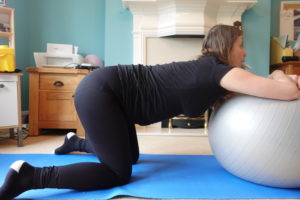Magic Pregnancy belt:
Pelvic support belt
Today, I am going to talk about a topic very important to me as a woman health physiotherapist: lumbar support belt!
More than 1 out of 2 pregnant or post-partum women suffer from pelvis ligament pain. If not treated, this pain can persist and become chronic…
Don’t forget, even at age of 4, your kid (yet a lot taller) will still ask to be carried in your arms. Therefore, it is essential to protect your back from the beginning.
Throughout pregnancy, hormonal changes make your ligament more elastic and weaker leading to a lack of support. It is the main cause for sacroiliac pain (lower back), pubis symphysis pain (groin) and hip pain.

As most painkillers are forbidden during pregnancy, drug treatment won’t do much. Physio and osteopathy treatment are nice and can relive a lot of pain but yet pregnancy progressing your hips open even more and the pain comes back…
So to prevent these pains and to optimize manual treatment there is a need for an increase pelvis support. Physiomat belt is not a classic lumbar support belt as it does not press on the abdomen which would prevent a good function of abdominal muscles and lead to increase abdominal pressure. Therefore, it is not a belt substituting for you abdominal muscles but on the contrary, it allow to engage correctly your transverse and deep back muscles as it enhance a good stretchy posture.
Additionally, it maintains pelvis structure and organ in an optimal position, preventing overpressure on the anterior wall of your belly and potential gap in between your muscles also named diastasis. It is pelvis stabilisation allowing to move around easily (you can even dance with it! I swear I tried!) and creating no pressure on your belly. Just be careful to loosen the belt when sitting for while (like at your desk).
After you gave birth, I am sure you noticed despite only 3 kilos remaining from the pregnancy, your hips doesn’t fit in your jean?!
It is normal, it your pelvis fault!

Throughout pregnancy, pelvis structures need to open to provide space to your growing baby. The push of the delivery is supposed to close it. However, when the push is too long or short, not efficient or in C-section, the pelvis doesn’t close completely. In various cultures, included ours decades ago, new moms were swaddled for several days to help this pelvis closure.
Nowadays, we leave the hospital 2 days after we gave birth. We end up walking, pushing a stroller or using a baby carrier (have look at my article on sling to understand why I am not a big fan of baby carrier) or having to stay standing up and sitting in incorrect way. All of this preventing the correct closure of our pelvis.
It is also our fault (as medical professional). We are always repeating “no abdominal or perineal work before 6 weeks”. Whereas by gently starting it in the first few days, we could bring back way faster a good static and posture. Obviously, I am not suggesting to do core muscles exercises in the first few days (even less crunches or sit up!). I am speaking about gentle active mobilisation of the abdomen and perineum (have a look at my article on ABDO-MG giving a good method for exercising in the following days of the birth)

Due to this abdominal/perineal passivity, wrong carrying and prolong standing up, we are prone to prolapse, sacroiliac dysfunction and diastasis .
Therefore, pelvic belt can be used for the pregnancy in case of hyper laxity with pelvic pain, sensation of heaviness in lower belly, uterine contraction or incontinence. But also, after delivery, for any woman who has to stand up or to carry. And especially after a C-section!
This belt is not only useful for pregnancy. For example, for patients with a prolapse of a weakness of this area, during period of intense cough or when you know you will have an activity increasing your intra-abdominal pressure (sport, carrying, singing…).
I want to make clear; I have no contract with “physiomat”. I am citing this brand for pelvis belt because through my 7 years of practice as women health physiotherapist it is the pelvic belt I found the most efficient. Other brand exist (look online, you will find some!).
I can only share my experience, up to you to make your own opinion. Don’t hesitate to give your impressions about it and to ask your question!




3 Responses
Hi Laura,
Thank you for your comment. You can find the link in the shop section:
https://myfrenchphysio.london/shop/
Do not hesitate if you have other question
Elodie
Hi Elodie,
Thanks for your reply, but I can’t find it on the shop page?
Best
Laura
Hi laura,
Here is the direct link: http://www.physiomat.com/PBSCProduct.asp?ItmID=13097372#S8
But you also can find it on Amazon.
Best
Elodie